All in one SaaS eCommerce site builder platform, built to load fast, scale and grow online sales quickly.
Don't wanna be here? Send us removal request.
Photo

7 secrets of becoming a successful entrepreneur
Before achieving success, it is necessary to go through a long and arduous path. Nothing comes easy! Entrepreneurs need to work hard and invest resources and time to earn the results of their work. Today we will discuss seven tips for entrepreneurial success, which have been tested and recommended by several famous successful entrepreneurs.
Let’s start.
Be firm in your decisions
Determination is half the battle. To run a successful business, you must be firm in your decisions and take risks without hesitation. It takes hard work and perseverance to succeed in the entrepreneurial world seriously.
“I’m convinced that about half of what separates successful entrepreneurs from the non-successful ones is pure perseverance.” – Steve Jobs
Don’t copy, create your own
Be different with your ideas. Never copy the ideas of other entrepreneurs. By being different, you take a clear position in the competitive field, which also contributes to the growth of the company.
“You should learn from your competitor but never copy. Copy and you die.” – Jack Ma
A powerful team
In a competitive field, you are unlikely to survive alone for long. Having a strong team is one of the keys to success. By choosing team members, you share your passion with a group of people who believe in and strive for business success.
“Great things in business are never done by one person. They’re done by a team of people.” – Steve Jobs
Visualize business goals
You must clearly define short-term and long-term business goals that will make you a successful entrepreneur. The process of achieving goals may be time-consuming and resource-intensive, but the result is sure to be satisfying. So take action today by setting clear and realistic business goals.
“Visualize your ultimate goal and then do the work to make it happen. ” – Suzanne Somers
Know your customer’s needs well
Successful entrepreneurs know who their customers and target market are. One of the most common reasons a business fails is that there are no customers. Before starting a business, you should conduct market research to understand what kind of customer needs your product or service offers. Without a customer, you don’t have a business! So start meeting the demands of your customers and understanding their needs.
“Focus on your customer and lead your people as though their lives depend on your success.” – Warren Buffett
Create value
Create value, not just offer a product or service! Customers love to be noticed and cared for, so by delivering value, you extend their lifetime value.
“If it doesn’t add value, it’s waste.” – Henry Ford
Manage risks
Taking risks is an integral part of business, but you must also be able to manage them. Thinking several steps ahead before acting is one of the keys to success. Here it is important to have a strong analytical and leadership mindset.
“If you don’t invest in risk management, it doesn’t matter what business you’re in, it’s a risky business.” – Garry Cohn.
5 notes
·
View notes
Photo
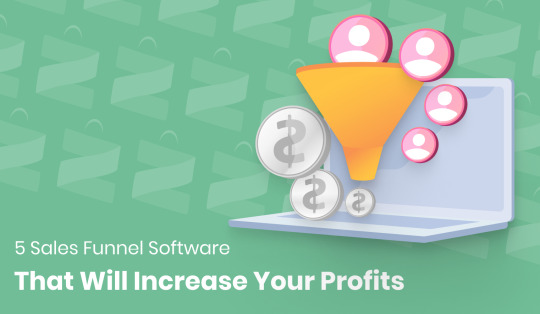
5 Sales Funnel Software That Will Increase Your Profits
What is a sales funnel?
A sales funnel, sometimes referred to as a marketing funnel or revenue funnel, is a customer acquisition process, a sequence of stages through which a large number of potential customers are filtered to generate leads for a company. The typical sales funnel is divided into multiple steps, which differ depending on the particular sales model. There are four main stages.
Stage 1: Awareness
In the first stage of the sales funnel, you need to inform potential customers about your product or service. Awareness can take place both using traditional marketing and digital marketing branches.
Stage 2: Interest
The next stage is to generate interest among potential customers. When they are well versed and have enough information about your product or service, they will already be motivated to put it into practice. They will also be interested in comparing your competitors and understanding what problem your product and theirs solve.
Stage 3: Decision
Ultimately, that interest will drive potential customers to make a decision. Sales pages, webinars, and calls are helpful in this stage to help sway prospects to make a purchase.
Stage 4: Action
The whole purpose of a sales funnel is to convert a potential customer into a lead. This stage is the final and decisive stage of the funnel. You might have ten potential customers, and only one will go through all the sales stages and become a lead. After this result, it is necessary to analyze the performance of funnel stages and make improvements to generate more leads.
Why is the sales funnel important?
A sales funnel helps you stay informed about a potential customer’s activities at every stage of the buying journey. All this makes it possible to use the right marketing tools to stimulate the interest of potential customers in your product or service and turn them into existing customers of the company.
The 5 best sales funnel software tools
HubSpot Lead Management
Powerful sales software to help teams close more deals, deepen relationships, and manage their pipeline more effectively — all on one easy-to-use platform. The platform’s robust suite of features includes conventional sales funnel tools like landing page templates, infrastructure for creating and distributing content offers, and email automation.
Starting price: $0/month (Free)
ClickFunnels
It is probably the most popular and widely used sales funnel software in the world. ClickFunnels has crossed over 142,000 active members as of October 2020. It offers users the ability to quickly stand up landing pages with a simple drag-and-drop editor. ClickFunnels also comes with a suite of supporting marketing tools like email funnel follow-up, SMS sending, and Facebook marketing automation.
Starting price: $97/month (Free trial available)
Kajabi
It only takes a few minutes to customize and launch Kajabi’s pre-built frameworks for lead generation, product launches, or webinar funnels. You can even connect several different sales and marketing channels into seamless multi-channel funnels.
Starting price: $119/month (Free trial available)
Kartra
Engineer a multi-page funnel flow to convert visitors into leads, leads into customers, and customers into recurrent clients. One of the most liked features of Kartra is its split testing feature. This feature allows you to create two variations of the page you are testing, and both the pages are shown in the browser. After the pages are live during testing, you can check which page performed better and process accordingly.
Starting price: $99/month
GetResponse
GetResponse is one of the few free sales funnel software available in the market. Some of its efficient and reliable features are lead magnet funnels, sales funnels, and webinar funnels. For the ease of the customers, email support is available in over 8 languages.
Starting price: $0/month (Free)
Summary
We think the information suggested about a sales funnel and sales funnel software will be helpful for you. Naturally, you need to do proper market research to choose the best sales funnel software for your industry. In this article, we presented the top 5 sales funnel software that is up-to-date and effective.
#Sales Funnel#Increase your profits#Software#Awareness#Interest#Decision#Action#ClickFunnels#Kajabi#Kartra#GetResponse#Summary#zegashop
1 note
·
View note
Photo
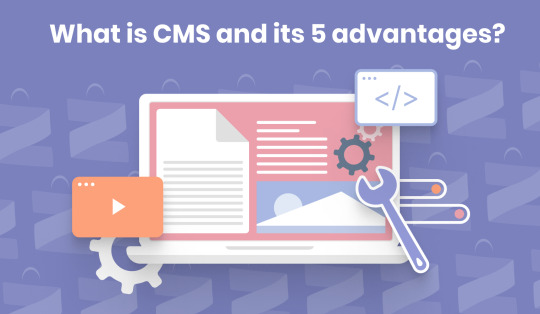
What is a CMS? 5 Advantages of using a Content Management System
CMS definition
A content management system (CMS) is a digital application that manages content, allowing you to create, format, edit, and publish content for presentation on a website. It helps you create and manage a website via a user-friendly interface. Multiple users can access the system.
Nearly every CMS comprises two parts – the front end and the back end.
There are different types of content management systems – Coupled CMS, SaaS CMS, Decoupled CMS and Headless CMS.
A CMS comprises two core parts: a content management application (CMA) and a content delivery application (CDA).
The CMA interface allows users to create and manage corporate or website content. The content delivery application (CDA) works in the back end, compiling any content changes and publishing them to the site for visitors to see. Using CMS digital application, you have the opportunity to create a website without coding skills.
5 advantages of using a CMS
Easy deployment
It is easy to deploy and allows multiple users to log in and use the admin panel at the same time. You can easily adjust the overall design, look, and layout. Full website management takes place in one common admin control panel, through which you can add products, new content, edit and delete it. You can also install plugins for additional features.
Accessibility for non-technically minded users
It’s a great opportunity for anyone, especially those with no coding skills, to create and manage website content, and apply unique templates. There is no need to spend a lot of money to have a custom website design anymore. These apps allow you to use many ready-made designs that are both responsive and stylish.
Extensive blog features
You can publish highly optimized content to drive a lot of website traffic and convert them into leads. The main advantage of using a CMS is that the necessary features for publishing a blog are available. You can specify content-related keywords, meta description, and content design (font, font size, color, etc) at any time directly from the admin panel.
Regular technological updates
Even though you avoid using any encryption, you don’t need to keep up with technological updates anyway. With CMS, these updates happen instantly, you just need to follow up to get the new system update.
Cost Effectiveness
By using a content management system, you can save both time and money. You can activate monthly packages to get the same features that you would get if you paid a web developer to make minor changes to the site. It’s really quite easy.
Summary
CMS is a great tool to create a website without the help of a developer and manage it yourself. Investing in this system will be effective in boosting business growth. It’s also great from an SEO perspective because it provides many tools to optimize content.
0 notes
Photo

Google’s New Core Web Vitals Update
Google implemented a “broad core update” to its search-engine algorithm on May 25, 2022. Google has introduced new Core Web Vitals metrics: INP (Interaction To Next Paint) and TTFB (Time to First Byte).
INP refers to how the page responds to specific user interactions that are programmed into the overall INP metric measured by Google Chrome’s lab data and field data.
TTFB measures the length of time that it takes for the first byte to be transferred by the server. With TTFB, SEO pros can measure how their site performs at the server level.
Now more details about INP
The measurement of INP is a representation of how long a user has to take in order to interact with the entire page. It is designed to provide a representation of the overall interaction delay of a page.
Google’s web.dev documentation explains that a good INP value is around 200 milliseconds or less.
Be aware of the following:
An INP below or at 200 milliseconds means that your page has good responsiveness.
An INP above 200 milliseconds and below or at 500 milliseconds means that your page’s responsiveness needs improvement.
An INP above 500 milliseconds means that your page has poor responsiveness.
Some INP issues arise because people do not optimize their main thread work enough to make sure that things are properly viable from a Core Web Vitals perspective.
Others can be caused by JavaScript file misfirings and a lack of attention to how things load on the page – especially with larger images.
You can use the Google Chrome Extension called Lighthouse to measure INP.
Indeed, improving your INP won’t do everything to ensure instant SEO success, but it can contribute to changes in overall SEO performance.
1 note
·
View note
Photo
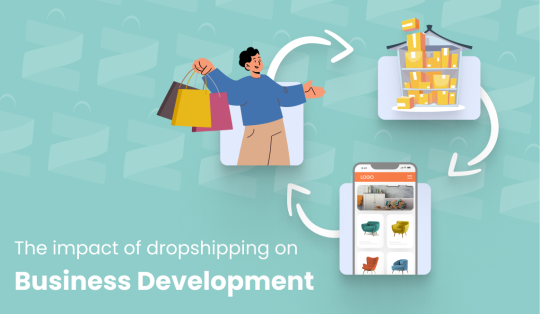
The Impact of Dropshipping on Business Development
Hey everyone!
In this blog, we will talk about the importance of dropshipping and its impact on business. Let’s discuss how to get started and some FAQs that you may be interested in.
The meaning of dropshipping
Dropshipping is a retail fulfillment method where a store doesn’t keep the products it sells in stock. It consists of 4 main steps. In the first step, the customer purchases from the online store. Then, your store automatically sends the order to your dropshipping supplier. After that, your dropshipping supplier prepares and ships the order. Finally, your dropshipping supplier ships the order directly to your customer.
Benefits of Dropshipping
Easy to start – With drop shipping, you don’t have to worry about packing and shipping, handling returns and inbound shipments, and managing stock levels.
Wide selection of products to sell – It’s a huge opportunity for all the small business owners who don’t want to spend much money to start a business.
Disadvantages of Dropshipping
Low margins – Low margins are the biggest disadvantage to operating in a highly competitive dropshipping niche. Because it’s so easy to get started, and the overhead costs are so minimal, many competing stores will set up shop and sell items at rock-bottom prices in an attempt to grow revenue.
Stock Shortages – Sudden stock shortages are one of the most common problems sellers have with drop shippers. If customers suddenly rush for a particular product, the drop shipper may sell out, leaving you in a situation where you have orders to fill but no products.
Read more about the pros and cons of dropshipping here.
Now, let’s discuss how to start a dropshipping business.
First of all, you need to create a dropshipping business model.
There are three key players in the dropshipping business model: the supplier, the retailer and the customer.
In the dropshipping business model, the customer buys the products directly from the retailer. The retailer buys the same product from the supplier. The supplier ship the product directly to the customer. The customer never gets to know about this process, continuing to purchase as they would on any eCommerce site.
Everything you need to start your dropshipping business today
Having a great business idea
You have to have a different and unique idea and be full of motivation to implement that. Understand the target audience and create an idea that will satisfy people. It’s the most important part of starting a dropshipping business.
Start partnering with suppliers
Suppliers are one of the key players in the dropshipping business. Research the market and find the right supplier for your business. Different marketplaces offer their list of suppliers, which can help you make the right choice. It is recommended to cooperate with at least 2-3 various suppliers at the same time.
Building a Dropshipping Business Store
The next most important step is to build the website. Start partnering with eCommerce website builder platforms that will make it easy for you to have a responsive website. Zegashop is one such platform, you can find more details here.
Dropshipping business FAQs
How much of an investment is needed to start a dropshipping business?
Dropshipping is a business model that doesn’t require a lot of investment. A minor investment needs to be made in marketing and customer support to boost your business’ traffic and increase your profits.
Should I have a business license in order to run a dropshipping business?
Any type of licensing is preferred. For example, the most common entity chosen among dropshipping companies is a limited liability company (LLC).
Is dropshipping legal?
Yes, dropshipping is legal.
Are dropshipping suppliers also responsible for customer support?
Customer support and additional services are the responsibility of the dropshipper. You act as a link between your dropshipping supplier and your end customers.
Conclusion
Dropshipping is a great complement for most experienced eCommerce companies. We hope you found the article helpful and will apply its tips when starting a dropshipping business.
19 notes
·
View notes
Photo

Why is eCommerce the most challenging business?
E-commerce is one of the leading and tremendous industries in the global market. But no fast-growing and profitable business is guaranteed to fail. Challenges are inevitable! The eCommerce market shows about 80% failure rate as per studies. Challenges occur in all industries, and eCommerce is no exception. E-commerce sales are expected that grow to $5.5 trillion by 2022. Therefore, managing the market becomes increasingly complex and the impact of challenges is inevitable. Top 3 eCommerce industry challenges that can cause business failure.
Data protection and cyber security
Maintaining state-of-the-art technological security is the foremost and most crucial requirement for all business owners when starting an eCommerce business. Security is one of the main reasons for customer concern. Maintaining website security is about protection from cyber-attacks and payments, excluding customer data leakage. The main desire of eCommerce customers is a better shopping experience. Frauds kill businesses, leading to failure! Software updates, frequent data backups, powerful payment system integration, and a great hosting provider are the main points to protect customer data as much as possible and provide a better website experience.
Customer Digital Experience
A website visitor only needs 10 seconds to rate the experience on the website. No dogma! We all have just 10 seconds to grab a visitor’s attention. The first thing a visitor notices is the speed of the site. So it’s not wise to lose potential customers because of a slow website speed, don’t you agree? Second, the visitor should feel comfortable on the website, so the functional layout of the website is also one of the reasons to change the customers’ digital experience. And lastly, to not restrict visitors and allow them to operate. Integrate several payment systems on the website, giving customers a wide choice. Maybe it’s a small thing, but it’s momentous!
Conversion Rates
One of the perennial challenges of the e-commerce industry is changing the conversion rate on a website. The hard part of website development is converting visitors into customers. It requires using a specially designed marketing strategy, calculating risks, and launching marketing campaigns to convert as many customers as possible. Changes in the conversion rate are mainly affected by website loading speed, SEO, website design, and CTAs used on the website. So, having a sensible marketing strategy is essential in this part!
Managing an eCommerce business can be a difficult task. Facing challenges is also difficult. But you should receive them as new opportunities, thanks to which you can raise the business to a new level. So act now!
0 notes
Photo
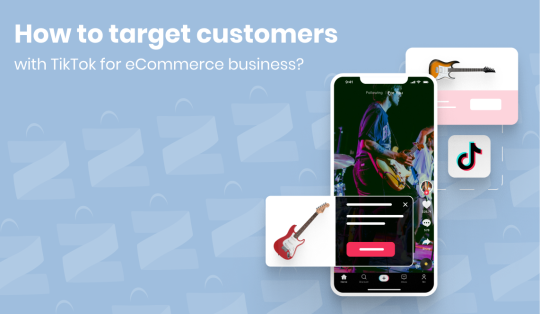
How to target customers with TikTok for eCommerce business?
Released in 2016, TikTok got a lot of attention in 2017 when it bought the popular app Musical.ly. According to Cloudflare’s research, the TikTok boom began in 2020, about two months after the pandemic began, and peaked in 2021, leading a platform with high web traffic. Today, TikTok occupies a gigantic position as a social network!
It is a critical asset for today’s brand marketing. In terms of attracting customers, increasing sales, and increasing brand awareness, marketers claim that TikTok is the best platform, surpassing even Instagram and Facebook. Therefore, it cannot be missed from your eCommerce marketing strategy. So, this article will show you how to use TikTok to target potential customers.
Use quirky videos
Unlike other social networks, TikTok’s algorithms focus on rare and unusual videos, which become trending and used by individuals and brands. A general part of a brand’s marketing strategy should be creating TikTok-specific content, choosing the right influencers, and filming videos. Yes, yes! It may sound funny and frivolous, but TikTok’s algorithm considers weird video content more effective. New video content also impacts SEO, thus increasing video exposure and views. In the early days of TikTok’s rise, most of the audience was teenagers, but now the platform’s content is changing, and so is the age structure of the audience. Therefore, informational videos are also becoming dominant now. This is a great source for targeting potential customers by telling them about the benefits and usefulness of your product/service.
Collaborate with TikTok influencers
TikTok was a new challenge for influencers to start their activities on a new social platform, presenting themselves only in video format. It was a great experience!
A new motive for influencers was the TikTok Creator Fund, through which TikTok rewards the creativity of its users. Let’s look at an example of a collaboration between a brand and a TikToker. According to Forbes’ survey of the top-paid TikTok creators, Khaby Lame is considered the most followed creator on TikTok. He is now considered the ambassador of Hugo Boss and Binance. With more than 143 million TikTok followers, Khaby Lame signed a deal with renowned fashion brand Hugo Boss in January 2022 intending to increase sales from $ 3.1 billion to $ 4.5 billion. The campaign is still running and is being used under the #BeYourOwnBOSS banner, although the results are unexpectedly high. If you think only clothing and shoe brands will work with TikTokers – you’re wrong!
Just check out Khaby’s new partnership as an ambassador with Binance, promoting how you can start your Web3 journey. Binance x Khaby Lame collaboration will launch exclusive Khaby Lame NFT collections, drive crypto and Web3 education and debunk myths. It is how TikTok changed the influencer marketing industry by turning influencers into brand ambassadors, so if you’re not using this strategy yet, it’s time to start.
#Tag Challenges
TikTok has breathed new life into the use of hashtags, making them an integral part of its platform’s content. It is an innovative approach to attracting an audience around a common goal. For example, in 2019, TikTok launched the #BetterMeBetterInternet challenge in collaboration with 29 NGOs on the occasion of Global Safer Internet Day. This challenge aims to encourage children and adolescents to use technology and mobile phones more responsibly.
Brands, brand ambassadors, and influencers also follow this rule and organize #Tag challenges. It is a strategy to increase follower engagement!
Final Thoughts
As you can see, TikTok is a very promissory platform for growing your eCommerce business and reaching customers. It offers incredible opportunities to businesses, surpassing other social networks. If you haven’t done so, it’s time to create a TikTok strategy and grow your business accordingly.
0 notes
Photo
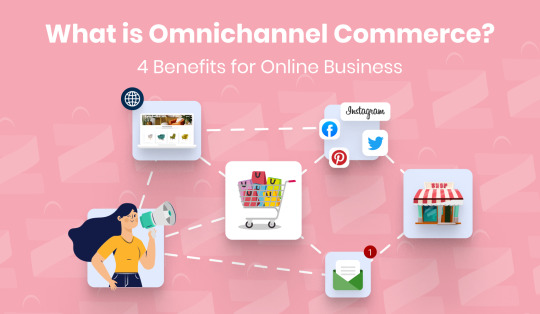
What is Omnichannel Commerce? 4 Benefits for Online Business
Omnichannel commerce offers customers a better experience across all platforms. It’s a multi-channel approach that combines customer experience across all channels to improve sales. However, one should not mistakenly think that omnichannel commerce is about providing customers with different ways of buying, it’s a broad concept that should be used both to have a good customer experience and conduct marketing campaigns to increase sales.
Some facts and statistics say more about omnichannel commerce than any article or publication.
– Due to the seamless communication experience, nearly 80% of customers prefer omnichannel strategies.
– As opposed to single-channel, omnichannel marketing provides an increase in purchase frequency by 250% and a growth in the AOV (average order value) by 13% per order.
– By 2023, the global omnichannel retail commerce market is projected to grow to $11.01 billion.
Top 4 benefits of omnichannel commerce for online business owners
Omnichannel commerce allows customers to shop from their convenient platform, which eliminates any barriers that may prevent the customer from confirming their final purchase. Here are 4 benefits of omnichannel commerce for online business owners.
Customer retention
One of the main tasks of any business marketing strategy is to extend and maintain the customer life expectancy (LTV). The cost of living for customers is to provide them with a good shopping experience and to meet their needs. Customers need to feel safe and to be able to find their favorite brand products or services on different platforms. Omnichannel commerce solves these problems! It’s a fantastic marketing strategy to offer customers to buy and find their favorite brand products on various channels, from offline stores to eCommerce sites.
Revenue growth
According to statistics, omnichannel marketing increases the frequency of purchases by 250%. It proves the growth of the business conversion rate through omnichannel commerce. The benefits of omnichannel marketing strategies are especially evident in online businesses. According to research, omnichannel customers spend 10% more than others. Therefore, from the point of view of revenue growth, you can use different marketing channels to formulate omnichannel marketing strategies.
Multi-channel sales management
Coordinating sales through various means facilitates communication with customers, which also helps businesses to have a clear position in the competitive field and increase their reputation. 77% of solid omnichannel companies store customer data across different channels, expanding the customer base. Thus, through omnichannel commerce, companies can improve their services in advance to have a good customer experience, collect a wide database, and expand sales.
Offline and online store combination
In this digital age, having an online presence is a prerequisite for businesses to survive in a competitive environment. Omnichannel commerce is the best way to understand the benefits and differences between offline stores and online shops. Through this strategy, companies can clearly understand the sources of profits received to improve the way forward.
Summary
Omnichannel commerce is a new opportunity for businesses to maintain their position in the competitive field. Therefore, companies need to be aware of its potential benefits, as it offers customers a seamless experience across all platforms, meeting their needs and wants. It’s not an easy process, but the results are more powerful in this case, so you should spare no effort to move to such an omnichannel marketing strategy.
2 notes
·
View notes
Photo

Why is site analytics important for better store performance?
Web analytics is the process of analyzing visitor behavior through website data tracking, reviewing, and reporting. Web analytics is part of CRM analytics to understand web pages that provide a better user experience. Through web analytics, businesses can realize the image of their perfect buyer persona, the active hours of visitors to the site, the dollar volume each customer spends, and other necessary analytical data. Let’s find out why website analytics is one of the most portentous parts of better store performance.
Customer experience evaluation
First and foremost, you need to identify the target audience for your product/service. Businesses can get an idea of their ideal buyer persona and their interests. Thanks to all this, it is possible to keep visitors on the site for a long time, understand their behavior and become paid leads.
Improve site ranking in search engines
Analytics has a primary role, especially in determining search engine rankings. With several analytics tools, such as Google Analytics, it is possible to check site traffic in real-time and the main links from which the site has had visitors. It may sound simple, but you need good structured data analytics that will allow your business to deliver what the customers want from you. Only customers will be more specific about their needs, so start making inquiries, interacting with your customer, and trying to meet their needs.
Successful marketing campaigns
Before conducting marketing campaigns, it is necessary to thoroughly analyze the results of previous campaigns and understand how the marketing channels worked, the number of visitors, and sales. And you know that if you do marketing research and study the data of previous marketing campaigns, you will not have to invest millions of money to make advertising campaigns. Previous experience will help to better understand the customer’s needs and to give a full answer to them. You can use some marketing tools to analyze your marketing campaigns’ results in real-time.
A great marketing tip!
Use Google Campaign URL Builder to link to your marketing campaign and follow it! Follow the links to get detailed information about the campaign process.
Web service optimization
The site content needs to be updated from time to time to keep visitors on the site for a long time. Through web analytics, you will find the main problems on the site. Invalid links, errors, warnings, and crawled pages can cause visitors to leave the site. Use site testing service optimization to correct bugs for a better customer experience.
Final words
Data analysis is one of the key points through which companies can achieve a competitive advantage, have a good customer experience, and increase profits. It is essential for the implementation of further marketing and advertising campaigns. There are many site analytics tools, such as Google Analytics, that you can integrate to get all the site data in real-time.
2 notes
·
View notes
Photo

The Impact of Machine Learning on the eCommerce Industry
Artificial intelligence is now a new opportunity for businesses to automate to the next level. Machine Learning is a type of artificial intelligence that allows software applications to be more accurate in predicting results without having to be programmed to do so. Have you ever wondered how machine learning can have a positive impact on your eCommerce business? In this digital age, you should try to develop any business tool that will also affect your conversion rate. So here are some tips on the impact of machine learning – why start today?
Revenue growth
Have you ever wondered why, when we think of something, we find information about it directly on social media? Are they eavesdropping on us? But there is one sensible answer to all this, and that is machine learning!
Imagine one case: Do you want to buy a bag from Amazon of any X brand? You completed the order and leave the site. Three days later you visit Amazon again to buy clothes. But on the home page of the site, you will find offers about bags, pop-ups about discounts on relevant bags, etc. At the heart of all this is machine learning, which, based on the types of searches performed on the site, can respond accurately and quickly to offer the best products. This also ensures a good customer experience, as it facilitates the customer’s product search process by immediately offering the best products that define their interests.
Dynamic price adjustment
Customers feel more valued when the price of a product is specially and reasonably chosen for them. Here comes machine learning! The role of machine learning in eCommerce has not been as significant as it is now. Based on market trends, and product demand, user-generated internal data can create a Price Adjustment circle for any customer, providing them with the best experience in your online store. This is a great way to boost your site conversion rate.
Make a conscious choice
It may seem simple, but it is not. By studying the customer journey on the site, through machine learning it is possible to understand whether people are interested in your product or not. Thus, this is a new opportunity to find out the scope of people’s interests and offer them a high-quality product.
Security is the key
By incorporating specialized machine learning tools into your online store, you can avoid security fraud. This is also one of the criteria for customer trust. A site with strong cyber security is one of the key points in gaining a leading position in the competitive market to show that you care about your customers.
E-commerce is a fast-growing industry, and machine learning is another stage of scientific and technological development, so the two are often interconnected. eCommerce is an area where machine learning technologies lead directly to the success of the user experience and business growth. Artificial intelligence has penetrated various fields of science, so it is necessary to use it in the field of eCommerce to take advantage of the opportunities provided.
0 notes
Photo
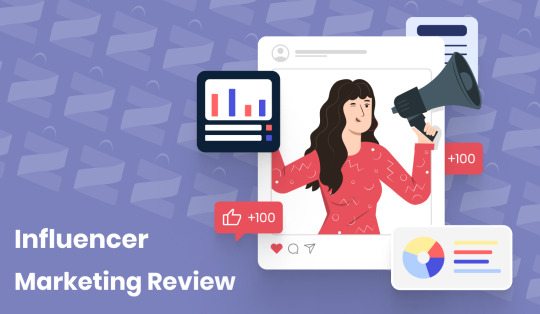
Influencer Marketing Review։ Industry changes after the pandemic
The pandemic revolutionized the online business industry. The influencer marketing industry has also undergone tremendous change. According to statistics, the influential marketing sector increased from $ 1.7 billion in 2016 to $ 9.7 billion in 2020. If 5-10 years ago only celebrities were used as influencers, today the situation is different. And as eCommerce and social media converge, influencers will become increasingly vital intermediaries, helping to connect brands with consumers on social media.
What is Influencer Marketing?
Influencer marketing is a collaboration with social media content creators and bloggers who influence communities and audiences of varying sizes. It is a big part of a strong marketing strategy. It is the new take on the old technique of using celebrity endorsements. The main purpose of influencer marketing is to increase brand awareness and attract new customers by using the target audience of influencers. On social media, we distinguish between macro, micro, and nano type of influencers. Fun fact: 67% of brands use Instagram for influencer marketing.
Influencer marketing growth after a pandemic
Can you remember how many businesses included influencer marketing into their marketing strategy before Covid-19? It’s a difficult question, isn’t it? Now marketers are valuing influencers like never before! The COVID-19 pandemic led to the cancellation of the brick-and-mortar trade, and the brands switched to online presence. The number of active social media users rose by 12.3% in 2020. Whether everyone was at home and content creators could not create content for their audience, the pandemic was a great way to promote influencer marketing. Marketers were looking for sensible solutions to get out of that situation and social media was the channel that was able to unite individuals with different audiences, bloggers, and influencers. It was an effective way to ensure business awareness and accessibility to consumers who were unlikely to leave their homes during the pandemic. According to statistics, in April 2020, more than two-thirds of US buyers made more online purchases than before COVID-19. All this was facilitated by the updates of social networks, which only had a positive impact on the work of influencers. Tik Tok has grown tremendously, ranking among the best downloadable apps. Global brands began collaborating with several celebrities and influencers, focusing their marketing budgets on brand positioning on social media. On March 15, 2020, YouTube saw a 500% increase in views, and digital media accounted for 59% of global advertising spending. During this time, the number of micro-influencers increased, and the percentage of influencer engagement became more important than the number of page likes.
Influencer marketing statistics post COVID-19
Partnerships with micro-influencers increased by 36.7% from the end of 2019 to April 2020.
Carousel posts increased by 34.2% and pictures decreased by 16.8%.
Social network users spent 2 hours and 26 minutes on social media each day.
90% of influencers sought ways to promote small businesses.
Instagram influencers to get a 67.7% boost in likes and more than a 50% increase in comments.
74% of B2B marketers think that influencers help improve business prospects and customer experience.
So influencer marketing is not as simple as it sounds! Influencers should spare no effort to build a loyal audience so that brands can show their confidence in advertising their product or service. A brand must be sure the influencer’s content aligns with their overall image. Given the rapidly evolving influencer marketing industry after the pandemic, marketers need to incorporate it into their business marketing strategy to launch an influencer marketing campaign.
Go digital, raise brand awareness!
0 notes
Photo
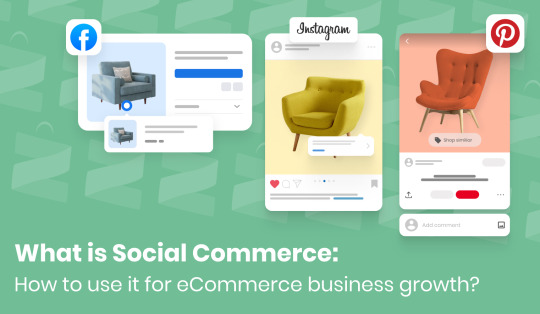
What is Social Commerce: How to use it for eCommerce business growth?
Create a product that meets your customer’s needs. Satisfying their needs, customers will start finding you without your intervention. It’s simple, but not all sellers understand it. The basis of all this is the solution to the customer’s problem.
Social commerce is an example of such a business – conducting commerce wherever your customers are, on their terms. According to statistics, social commerce will drive $ 604 billion in sales by 2027. It is a massive market for eCommerce sales. Let’s go into more detail below, discussing the potential of social commerce and much more.
What is Social Commerce?
Social commerce is the sale of products and services via social media such as Facebook, Instagram, Pinterest, etc. It is the type of sales that businesses use in addition to raising brand awareness. Social commerce is a massive market for consumers. It is the best-selling market type nowadays.
Why use Social Commerce?
As we have already mentioned, social commerce is a tremendous source of the target audience. It is one of the most important considerations for any business. The most important advantage is the opportunity to attract a new and more extensive customer base in the social commerce business. It is an excellent opportunity to build a better relationship between buyers by facilitating their purchasing process. Social commerce makes it easy for customers to discover your products and reduce any friction that could lead to the abandonment of their purchase.
The role of Social Commerce in the eCommerce business
A large part of marketing strategy is social media marketing. In addition to the brand positioning in the market, it also promotes social sales. It is one of the modern sales tactics.
The connection between social commerce and your eCommerce business is excellent. For example, Instagram has 1 billion monthly users, of which about 200 million are business profiles. This proves the huge impact of social media on the business sector. It is a fact that eCommerce has grown since the pandemic, and now social commerce is at its peak. Nowadays, social media is not just a platform for posting visual images. It is a powerful sales tool. New updates on social media are aimed at business development to facilitate a product/service sale. When running an e-business, you will probably encounter “Sell on Instagram”, “Sell on Facebook”, and “Sell on Pinterest” features. These are just some of the goal-setting software that you can use. Thus, social commerce is the new level of eCommerce: adapting the business to it will only increase sales!
Business growth tips through social media
Valuable advertising campaign
Today, businesses will merely disappear from the market without using promotion tools. The core platform for business development in the market is social media. Impressing a potential customer several times will result in a higher rate of return. It is a core point for any business, regardless of industry.
Integrate chatbots
Having a positive relationship with your customers is the key to positioning your brand. If you want to expand your sales, you need to automate the customer service process. Chatbots are great here! In addition to integrating additional tools, you can even directly access your social media (for example, Facebook) to create automatically answered questions.
Share reviews, gain prestige!
Word-of-mouth is one of the oldest methods of selling. Everyone wants to know product reviews before making a purchase. Positive feedback builds trust and confidence in the brand. So use this technique to position your brand correctly and gain the trust of your customers.
Final words
Social commerce is the newest method of attracting online business sales. It’s time to adjust to these changes. It’s one of the most important tools for expanding sales. Use the above methods to adjust social commerce to your business.
0 notes
Photo
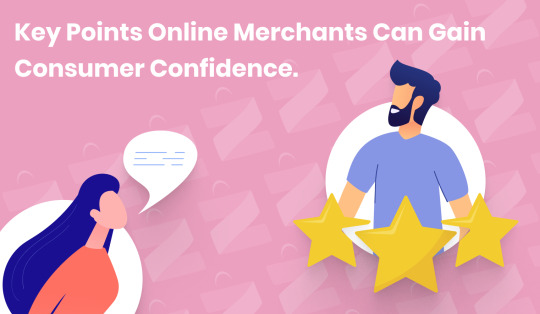
Key points online merchants can gain consumer confidence
As a supplier, have you ever heard of customers’ distrustful opinions and feedback during your business activity? Over half of consumers prefer shopping in a physical store. But why? What is the reason?
This behavior of consumers and attitude may be due to security reasons, fear of buying the faulty product, and unnecessary loss of money, especially when the supplier is in another country, the risk increases! According to Statista, in 2020, the size of the eCommerce fraud detection and prevention market was over 28 billion U.S. dollars.
It is where the potential for global brand power of businesses comes into play, which can at least survive in the face of consumer distrust, which is not the case with small businesses. Thus, the main points of gaining consumer confidence.
Improve digital security for a better customer experience
One of the main reasons for customer distrust is online data privacy and security concerns. Some eCommerce practices to keep customers safe in your online store: using a secure eCommerce software platform, encryption, and getting customers to know about your privacy policy. You can find more information on cyber security here.
Maintain accessibility to keep in touch with customers
Customers want easy, stress-free shopping experiences. One of the main aspects of ensuring all this is regular contact with the customers, taking care of each problem separately, and providing appropriate solutions quickly. Loss of trust directly correlates to customer churn. Communicating with everyone personally affects the customer’s psychology and indirectly builds trust in your business.
Note: Building customer trust and loyalty is a worthy goal for any business.
Share feedback by attracting potential customers
You get the opportunity to attract potential customers and become regular customers by sharing the feedback of existing customers. Regularly conduct technical and service surveys to improve quality. It gives the impression that you are taking into account the opinions of customers.
In any case, always listen to the customer!
Here’s the next step in gaining trust – do what your customer expects. If you sell antiques but do not have sales or generate customers, so what is the point of running a business? Give the customer what they want, and word-of-mouth will do its best to attract new customers. It’s a simple formula!
Ensure sales convenience
To ensure the best online shopping experience, you must adapt your website to different devices. People can use their phones, computer, or laptop to shop online, and it’s time to show them the stability of your business in the market and build confidence. The customer needs to get what they need right now!
Conclusion
Thus, long-term customer relationships are based on the security of the eCommerce platform, customer support, and easy access to customer service. Several international brands have built their reputation on trust and attracted the attention of customers. Take care of your customers’ business. That’s the only way to succeed!
0 notes
Photo

How to avoid cyber-attacks on your online store
There are more than 1 billion websites on the World Wide Web, according to a March 2022 Web Server Survey by Netcraft. And eCommerce sales are projected to reach $5 trillion in 2022. All of this is evidence of the rapidly growing eCommerce industry, accompanied by an increase in cyber-attacks.
E-commerce sites have always been a hot target of cyber-attacks. In addition to the loss of data of the company and its customers, cyber-attacks also significantly impact its reputation. They reduce the trust of customers!
If you are an online business owner and take care of your business, read the following cybersecurity steps to avoid threats.
Use the backup method
Great attention should be paid to customer data protection, as it jeopardizes the company’s reputation. One of the most popular ways to protect against cyber-attack is to back up your data. You can use daily, weekly, annual, and many other server backup methods to increase cyber security.
Install SSL Certificate
One of the best ways to improve cyber security is to set up an HTTPS protocol (HTTPS = HTTP + SSL). It allows you to secure data through a client-server and web browser. In addition to increasing security, it also helps get better rankings in the SERPs.
Create strong passwords
It may seem simple, but it’s not! One of the clue points of cyber security is using a strong password. Just avoid using the same password on all sites. Change your password in a short period, for example, at least once in three months.
Choosing the right eCommerce platform
When choosing an eCommerce platform, the necessary condition is to esteem its level of security. Use only SSL-certified eCommerce platforms, such as Zegashop.
In conclusion, it’s necessary to make huge investments for security. It is directly related to maintaining the reputation of your business. Start using the security methods listed above. You can also read what web security is here.
0 notes
Photo

4 reasons why brand storytelling is important
The best brands are built on great stories! Brand storytelling is a marketing method to connect a brand with its customers. It affects people and indirectly builds trust in your brand. Brand storytelling is a fantastic strategy for developing a dialogue with potential customers through content alone. According to Headstream, 55% of people consider buying from a brand if they love its brand story. It helps to evoke emotions with the brand! Here are some reasons why brand storytelling is important.
Brand personalization
Competitors are everywhere, and regardless of the type of business, brand storytelling is a key marketing strategy to become a leader in the competitive world. A brand is what sets your business apart! Storytelling gives you the perfect opportunity – a platform that allows your brand’s personality to take the center stage.
Customer relationships
One of the best ways to connect with people is to tell stories. By delivering value through its stories, the brand increases the likelihood that potential customers will become consumers of the brand.
Sales promotion
The goal of the brand, in addition to gaining a great reputation, of course, is to have sales. Interesting stories, in addition to generating interest in the brand, make you tell others about the brand, indirectly generating potential customers. Brand history is one way to influence sales, so this free method of promotion should be used wherever there are large numbers of customers. International brands use such a marketing strategy.
The role of emotions
People love to hear stories, and a masterfully written story captivates readers, keeps them hooked, and constantly reminds them of the brand. This is where emotions come into play! Emotions make your brand more human so you can have a deeper relationship with your customers. And as a result, trust will create a lasting bond between the brand and the customer, which will ensure sales.
Conclusion
Storytelling is a fantastic chance to connect with the customer and be able to influence their decision to purchase or not. Consumers pay close attention to the brand history before making a purchase, so a well-written brand story can do its best to increase sales and increase brand awareness.
16 notes
·
View notes
Photo
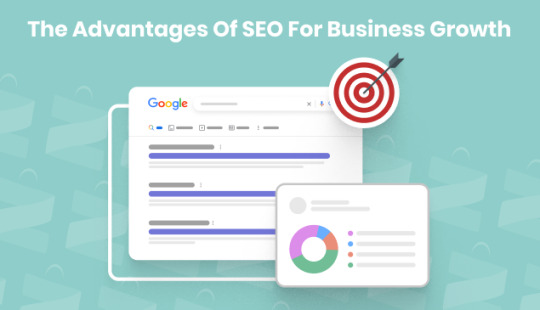
The Advantages of SEO for Business Growth
SEO is the best channel for brand visibility. It can also help raise brand awareness and generate new leads. According to statistics, more than 60% of B2B marketers said SEO generates more leads than any other marketing initiative. Organic visibility has the following 4 potential benefits.
Generate new leads
In addition to helping increase brand awareness, SEO also helps increase your total customer base. It helps you generate B2B leads directly by driving B2B researchers to your site during their decision cycle. The more your site dominates in organic search, the more likely it is to attract potential customers.
Product marketing
The best product is the one that sells automatically, solving customer problems. In product marketing, it is important to understand the problems of potential customers and provide adequate solutions that will automatically lead to sales. At this stage, one can understand the role of SEO, which helps to generate potential customers through organic search.
Mix PPC and SEO campaigns
Your organic advertising, SEO, is the best unpaid version of your ad, and your paid marketing strategies, PPC, work fantastically well, generating a huge amount of traffic. Both results appearing at the top of the search engine results page increase the credibility of your brand. You can use SEO and PPC together to get huge traffic and sales.
Improve BI
Business intelligence helps guide digital strategy, aligns with the goals of the organization, and has become an important aspect of enterprise SEO. Analyzing historical and real-time SEO data at scale, content, digital, sales, and product, can help marketers understand customer needs and preferences.
Conclusion
Brands that invest in SEO will surely benefit by making it a key part of their digital marketing strategy. It can lead to long-term exponential sales growth. SEO is an absolute necessity today! Companies that use SEO will have more and more organic traffic, which will help increase sales.
0 notes
Photo

Impact of Page Speed on Conversion Rates
Slow loading of a website is not only bad for your business, it just wastes your time, reducing your chances of making a profit. If you think that building a website is enough to start an e-business and increase sales, you are sorely mistaken.
Customer satisfaction is one of the most important prerequisites for generating sales, and the instantaneous speed of the site is the primary condition for influencing the conversion rate.
Did you know that the highest conversion rates for e-commerce take place on pages with a load time of 0-2 seconds? And how fast is your site loading?
4 points to prove the negative impact of a slow loading site on business
Loss of website traffic leading to losses in sales and revenues
A slow website can disappoint any user. This means a loss of incoming traffic that can further lead to lower user engagement and conversions. According to a website performance and revenue study, a 2-second delay in search results can incur a revenue loss of 4.3% for each user. The whole point of building a website for your business is so that people can visit the site and learn about your work or the service you are providing. But if a slow website is preventing you from accessing your site, then it defeats the purpose of building a website for your business!
Fall in search engine ranking
Having good content is not a sufficient condition for ranking high in search engines, as sites with poor speed can have a bad ranking on the search results page (SERP). Fast-loading websites are given a higher ranking which contributes to more user clicks and incoming traffic. Many factors enable websites to rank high. Google, the world’s largest search engine is normally tight-lipped about ranking factors, they have made it clear that website speed is one of the factors. Google states that: “We’re striving to make the whole web fast.” The search engine giant wants its users to have a fast browsing experience. Don’t you think it’s worth having a fast website just to rank high in the search engines?
Deteriorating user experience
A slow-loading website is the worst that can be encountered in the very first stage of the customer experience. It is a fact that 40% of online users leave the website if it takes more than three seconds to load. Slow sites lead to higher interest rates and lower shopping carts.
Increase in the user’s bounce rate and a lower rate of conversions
A site bounce rate is recorded when a user visits a site and leaves without taking any action. One of the key points is not leaving the site is fast loading, which reduces the likelihood of visitors leaving the site. With reduced engagement, your business may suffer from low conversions and overall sales.
Why does site speed improve your business?
Provides a high ranking in search results
Speed is a priority for Google. Even in 2009, Google launched the “Let’s Make the Web Faster” initiative, using the role of site speed. Page speed also affects your bounce rate or the percentage of sessions where a user leaves your site after visiting only one page. According to Google, as load time goes from 1 second to 3 seconds, the probability of bounce already increases by 32%. If your site is too slow, you run the risk of showing up lower in search results.
Improves user experience
No one likes to wait, the slowness of websites can force users to find hundreds of other similar websites on the web. Speed is an important factor in a user experience because they can not technically do anything on the site until it is loaded. The user experience affects how likely your site visitors are to convert, and consequently, if your users leave your site before they even see what you can offer, it will affect the conversion rate. Remember, a good user experience starts with a fast-loading site.
Makes advertising more effective in search engines
Ads displayed on Google are thoroughly monitored by experts and slowly loading sites can have a detrimental effect on ad campaigns. And what is the connection between them? There is only one answer. When someone clicks on your ad and the landing page loads too slow, Google considers it a poor user experience, likely causing the ad’s overall quality score to go down.
Speed affects your site’s indexation
You’ve probably heard about Google search engines’ so-called “allocated crawl budget”. In simple words, it is the demand for your pages based on their popularity and the relevance of your content, and the crawl rate limit, which limits the “maximum fetching rate” for your site, or the number of pages that the crawlers can “call” simultaneously and the waiting time between such calls. If the site loads slow or sends many connection timeouts, the crawl rate limit decreases and Google might stop crawling altogether. Thus, too slow loading time may be affecting your site’s indexation.
We hope you’ve learned enough about how website speed is important to automate sales and improve your customer experience.
Are you not going to lose customers and reduce the conversion rate through a slow-loading site?
Now we won’t list the ways to improve site speed.
Today you can have a faster loadable site for your business, without integrating any additional plugins, all in one platform!
Sign up in Zegashop move or build your website and have a great optimized platform!
Healthy SEO
Fast page-speed optimization
Google top ranking
Sales automation
Do not miss the chance to increase the conversion rate. Register here!
0 notes